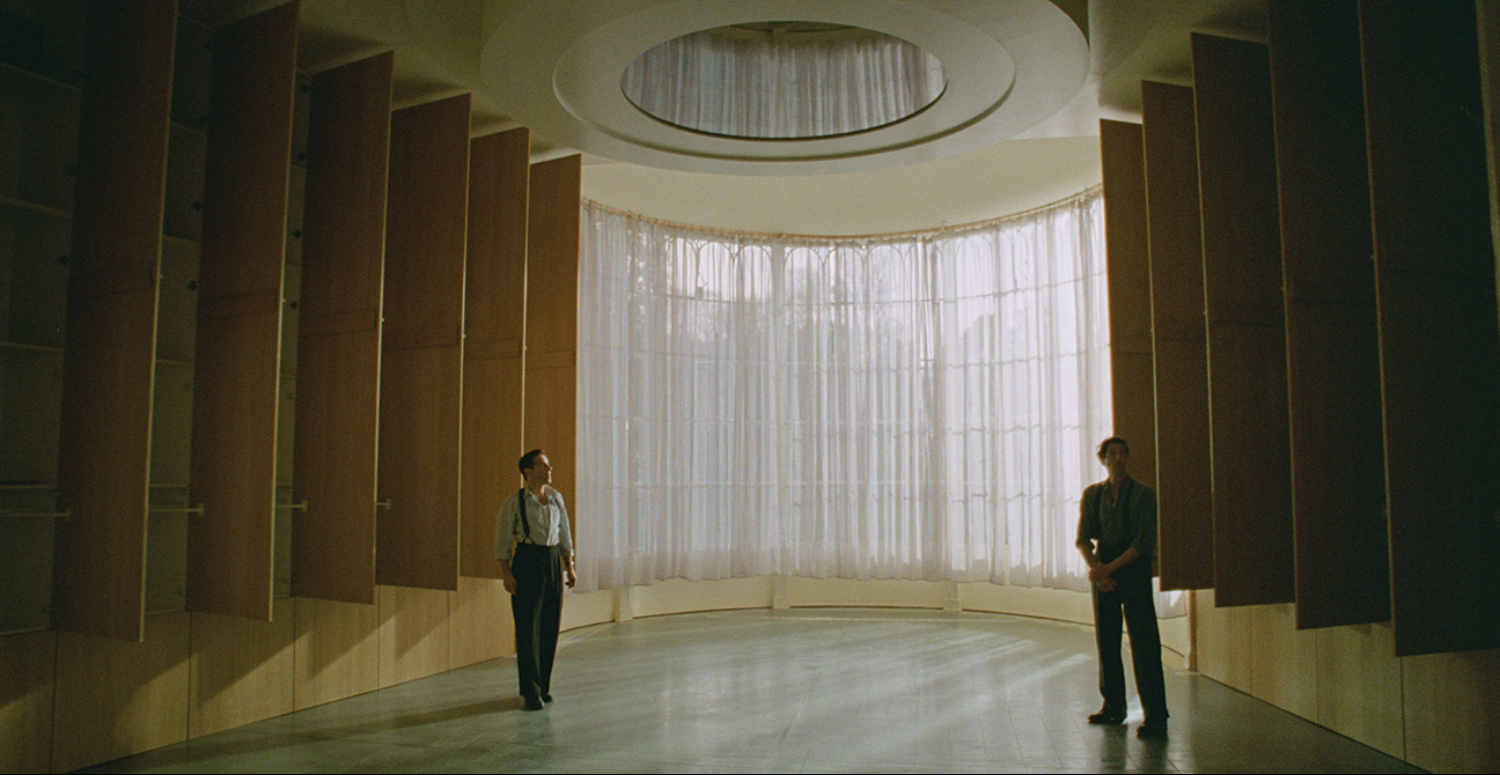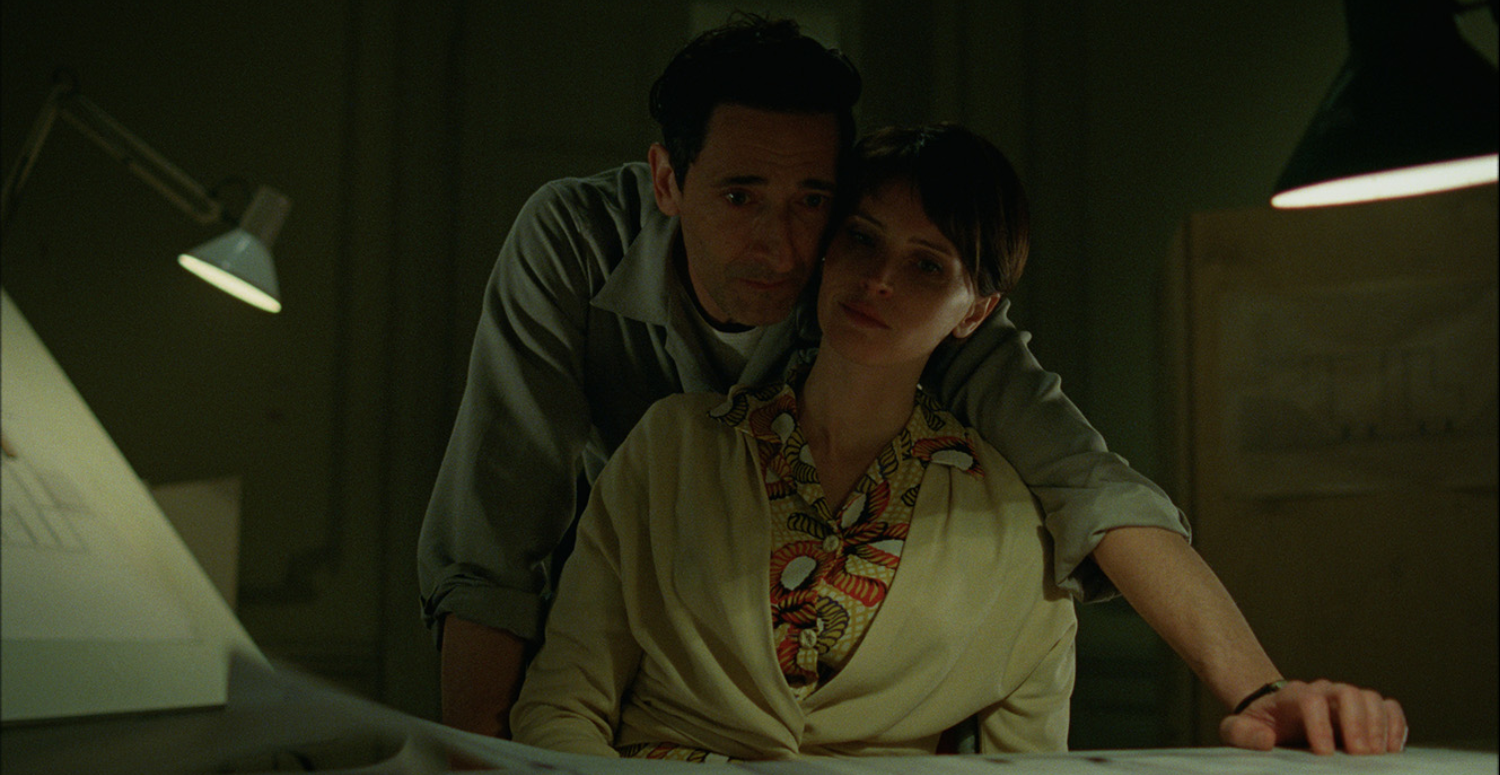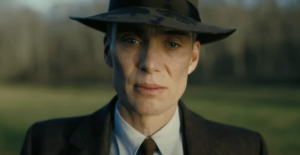The Brutalist
Lion d’Argent (Réalisation) – Venise
Best Actor – Oscars
Best Cinematography & Original Score – Oscars
Best Director & Best Lead Actor – BAFTA
Best Cinematography & Best Score – BAFTA
Best Motion Picture (Drama) – Golden Globes
Best Director & Best Actor (Drama) – Golden Globes
Best International Supporting Actor – Australia
2024/2025

FR EN
Dès la scène d’introduction, le ton est donné avec ce plan sombre et crasseux où le protagoniste remonte péniblement des entrailles du navire qui l’amène aux États-Unis. C’est l’arrivée d’un immigrant comme une ascension vers la lumière, jusqu’à sa découverte triomphale de la Statue de la Liberté dans un cadrage instable et surtout où le flambeau d’une statue qui porte au bout de son bras levé le Rêve américain est … à l’envers !
« The Brutalist » apparaît d’abord comme une anomalie dans le paysage cinématographique actuel de par son ambition narrative et esthétique mais aussi de par sa construction. C’est un film d’auteur en deux grandes parties (Ouverture & Chapitre 1 / Chapitre 2 & Épilogue) divisées par un entracte au milieu, qui couvre pas moins de trois décennies sur le destin douloureux d’un immigré hongrois venu goûter au Rêve américain en 1947. Ce personnage est un architecte visionnaire au passé indicible qui se retrouve dans une Pennsylvanie en plein boom alors que sa femme est encore sur le vieux continent. Il va (au sens propre comme figuré) se retrouver au charbon et dans la crasse jusqu’à ce qu’il fasse la rencontre (intellectuellement stimulante) d’un richissime mécène américain reconnaissant sa valeur et lui commandant la construction d’un édifice à l’image du film, à savoir hors-normes et multifonction, tout comme cette œuvre de 3h34 multipliant les thématiques et métaphores.
« The Brutalist » est ainsi une fresque historique et intime, à la fois macro et micro, qui parle donc bien sûr d’architecture, mais ce n’est pas l’unique thème du film qui est bien plus riche et ausculte aussi cette nation d’immigration (avec le cousin parfait exemple d’assimilation), ainsi que la discordance entre l’art et l’industrie ou encore le trauma d’un artiste et celui d’un couple. C’est un film qui raconte à la fois un homme, un pays, et un siècle à travers le portrait du leurre américain et d’une volonté artistique. C’est un film dense mais accessible, long mais sans longueur, et qui mérite réflexion.

Brady Corbet est en effet habitué aux histoires entrechoquant les thématiques pour former un tout après avoir réalisé « Vox Lux » en 2018 qui diagnostiquait déjà une certaine Amérique malade à la fois par le biais de ses tueries lycéennes et de ses pop stars. Ici il s’intéresse à l’influence majeure que la condition psychologique d’une époque, l’après-guerre, a pu avoir sur un mouvement architectural en inventant un personnage formé au Bauhaus, en partie inspiré de Marcel Breuer, et dont l’architecture froide et oppressante cache l’horreur dans la beauté de sa géométrie … ou comment un homme cherche de manière obsessionnelle à se reconstruire dans l’architecture jusqu’à y projeter ou y perdre une part de son âme. Adrien Brody (Le Pianiste) est quasiment de tous les plans pour incarner ce protagoniste emblématique aux côtés des excellents Guy Pearce (Memento) et Felicity Jones (Rogue One) dans des dialogues en anglais, hongrois et italien qui jouent avec minutie sur les différences d’accents et de vocabulaires des personnages.
Récompensé à Venise pour sa réalisation, Brady Corbet met en scène un style bien particulier à commencer par son tournage en pellicule et VistaVision (un processus de défilement horizontal de la pellicule qui évite les distorsions) qui lui donne le format de photographies. Tourné presque intégralement à Budapest dans des décors impressionnants, le ton est austère avec ses plans sombres, ses couleurs ternes et désaturées, et sa musique omniprésente battant la cadence et résonnant encore longtemps après la séance. Quasiment sans aucun champ/contre-champ, mais plutôt avec de nombreux plans-séquences y compris lors des scènes de dialogues, Corbet nous livre quelques scènes mémorables pour finir sur une clé secrète de l’œuvre. Et à l’image du parcours de son protagoniste, la photographie évolue progressivement de la crasse à la lumière pour finir sur un épilogue qui apporte un véritable changement visuel.
C’est un film dont on sort plus sonné qu’ému car malgré son point de vue interne, les personnages sont finalement peu attachants – peut-être parce qu’ils ont tous une part d’ombre ou d’horreur en eux – et c’est donc un film assez énigmatique (notamment avec une fin (pré-épilogue) qui aurait peut-être mérité une conclusion plus claire) et surtout froid, voire brut, ou brutaliste somme toute. Le titre est ainsi reflété par toute la nature de l’œuvre, de sa thématique architecturale à son esthétique visuelle, en passant par ses personnages ou encore sa partition imposante comme un édifice brutaliste. ‘The Brutalist’ renvoie ainsi non seulement au mouvement artistique dont le protagoniste est issu, mais aussi à une manière de se comporter, ainsi qu’à l’état même du pays décrit. Et au-delà de toute cette symbolique, le film en lui-même est aussi une métaphore du cinéma et du projet du réalisateur comparable à celui de l’architecte : un bâtiment et un film peuvent en effet nécessiter à peu près autant de monde et avoir autant de contraintes des différents collaborateurs …
Raphaël Sallenave
Right from the opening scene, the tone is set with this dark, grimy shot of the protagonist painfully ascending from the bowels of the ship bringing him to the United States. This is the arrival of an immigrant as an ascent into the light, leading up to his triumphant sighting of the Statue of Liberty in an unstable framing and, above all, where the torch of a statue carrying the American Dream at the tip of its upraised arm is … upside down!
“The Brutalist” stands out first and foremost as an anomaly in today’s cinematic landscape, not only for its narrative and aesthetic scope, but also for its structure. It’s an auteur film in two major parts (Overture & Chapter 1 / Chapter 2 & Epilogue) divided by an intermission in the middle, spanning no less than three decades on the harrowing fate of a Hungarian immigrant who came to experience the American Dream in 1947. This character is a visionary architect with an unspeakable past who finds himself in a booming Pennsylvania while his wife is still back in Europe. He ends up in coal and dirt, until he has an (intellectually stimulating) encounter with a wealthy American patron who recognizes his value and commissions him to design a building that reflects the film itself, i.e. out of the ordinary and multi-purpose, just like this three-hours-and-a-half film full of themes and metaphors.
“The Brutalist” is thus a historical and personal epic, both macro and micro, about architecture of course, but this is not the only theme of the film, which is much richer and also examines this nation of immigration (with the cousin as a perfect example of assimilation), as well as the discord between art and industry, or the trauma of an artist and that of a couple. It’s a film that tells both the story of a man, a country and a century, through a portrait of American delusion and artistic will. It’s a film that’s dense but accessible, long but not lengthy, and well worth reflecting on.

Indeed, Brady Corbet is no stranger to stories that bring themes together to form a whole, having directed “Vox Lux” in 2018, which already examined a kind of sick America both through its high-school killings and its pop stars. Here, he explores the major influence that the psychological condition of an era, the post-war period, may have had on an architectural movement by inventing a Bauhaus-educated character, partly inspired by Marcel Breuer, whose cold, overwhelming architecture hides horror in the beauty of its geometry … or how a man obsessively seeks to rebuild himself in architecture to the point of projecting or losing part of his soul in it. Adrien Brody (The Pianist) is almost in every shot to embody this symbolic protagonist, alongside the excellent Guy Pearce (Memento) and Felicity Jones (Rogue One), with dialogue in English, Hungarian and Italian that carefully reflects the characters’ different accents and vocabularies.
Brady Corbet, who was awarded a Venice Film Prize for his direction, brings a very particular style to the screen, starting with his use of film and VistaVision (a horizontal film-running process that avoids distortion), which gives the film a photo-like format. Shot almost entirely in Budapest on spectacular sets, the tone is somber, with dark shots, dull and desaturated colors, and the ever-present score beating out the cadence and resonating long after the screening. With almost no shot/reverse shots, but rather plenty of uncut shots including dialogue scenes, Corbet delivers some truly memorable scenes, ending with a secret key to his work. And like the protagonist’s journey, the cinematography gradually evolves from grime to light, ending with an epilogue that brings a real visual change.
It’s a film that leaves us more stunned than moved, because despite its internal point of view, the characters are ultimately not very endearing – perhaps because they all have some degree of darkness or horror in them – and it’s therefore a rather enigmatic film (especially with an ending (pre-epilogue) that perhaps deserved a clearer closure) and above all cold, even raw, or brutalist after all. The title is thus reflected in the entire fabric of the film, from its architectural theme to its visual style, as well as its characters and its score, as imposing as a Brutalist piece. ‘The Brutalist’ then refers not only to the artistic movement from which the protagonist comes, but also to a way of behavior, as well as to the very state of the country depicted. And beyond all this symbolism, the film itself is also a metaphor for cinema and the director’s project, comparable to the architect’s: a building and a film can indeed require just as many people and have just as many constraints from the various people involved…
Raphaël Sallenave

